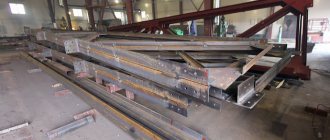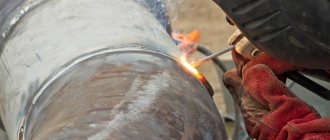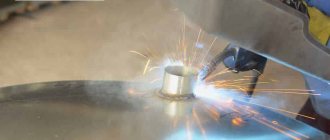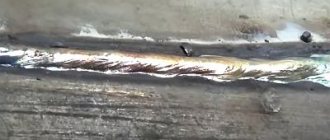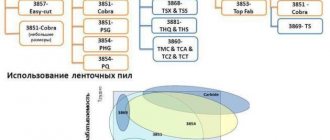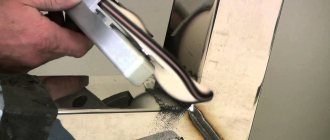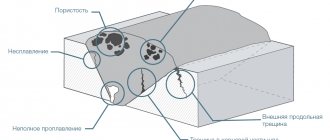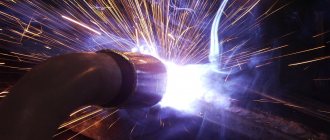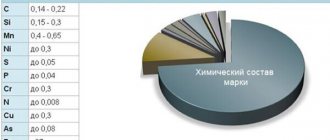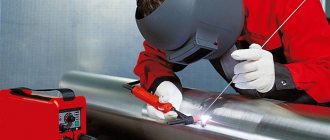Corrosion-resistant steels are materials that are characterized by difficulty in cutting, including milling. Therefore, for each group of stainless steels, optimal technological modes and cutting tools for milling machines are determined to increase the productivity of the processing process.
Stainless steel milling: main problems
In what way does the material show its complex character during milling of stainless steel?
Firstly
, during its processing, the so-called hardening is formed - a consequence of independent strengthening in the process of mechanical action. The hardened layer that appears at the cutting site interferes with further operation of the tool. The formation of work hardening is often the result of an incorrectly selected or blunt tool.
Secondly
, stainless steel has reduced thermal conductivity. In processing, this is a factor with a “minus” sign, since the heat generated during the process is not distributed throughout the material, but is transferred to the tool. The result is rapid wear of the cutters.
Third
, cutters quickly fail not only under the influence of thermal processes, but also due to contact with a material of increased hardness.
Fourth
, waste generated during cutting sticks to the tool. This factor not only worsens the cutter edge, but also “forces” the tool to work with double effort.
And finally, fifthly
: chips during processing are poorly crushed into smaller elements. This is harmful for the workpiece, since burrs may appear in the area where it is turned.
Properties of stainless steels that complicate milling
Characteristics that make it difficult to process workpieces by cutting include:
- Self-strengthening during deformation, called “hardening”. When the cutting edge of the cutter is pressed, the metal is deformed, as a result of which its hardness increases. If another pass is required, the tool will need to cut away the highly hardened layer. One of the reasons that causes this problem is an incorrectly selected and worn tool.
- Reduced thermal conductivity, making it difficult to remove heat from the cutting zone. The workpiece and chips absorb a small part of the heat, and the rest is transferred to the tool, which reduces its service life due to intense wear.
- High hardness and strength provided by alloying elements - nickel, titanium and others. When processing such material, the cutter experiences much greater loads compared to the process of cutting conventional carbon steels. Therefore, the tool quickly fails.
- Metal adhesion to the edge of the cutter. This leads to a violation of its geometry and an increase in cutting force.
- Difficult chip crushing and the formation of burrs on the workpiece. These problems are especially relevant in cases of incorrect selection of tools.
Milling steel and stainless steel
Unlike milling stainless steel, working with “black” rolled steel grades is not so difficult, but it also has its own peculiarities.
The choice of a specific technique depends on the type and amount of alloying components of the alloy. The main danger of processing low-carbon steels is the formation of burrs. The harder the material, the more difficult it is for chips to chip away from the working area, which we have already described using stainless steel as an example. It should be remembered that when performing simple operations, it is undesirable to use cutting fluids (coolants): this is a serious load on the material, which can cause its critical damage - cracking.
Stainless steel milling technologies
The milling method is used to process planes and ledges on various sections (rectangular or profile), machine shaped surfaces, and make grooves and grooves.
During pre-processing, the workpiece is fed towards the cutter (mill); during finishing processing, the workpiece is directed under the cutter, thereby ensuring high processing accuracy and a particularly smooth surface.
The milling process in the manufacture of stainless steel parts is optimized by the following techniques:
- Use of special carbide cutters with special sharpening. Such cutters do not deform the metal workpiece and effectively cope with metal cutting. Carbide cutters do not lose their performance characteristics at elevated temperatures.
- When working with corrosion-resistant alloys, special modes are selected: the maximum possible cutting depth is used, as well as a significant feed. In this case, it is necessary to take into account the power of the machine and the strength of the tool.
- It is necessary to correctly select cutting fluids (coolants), as well as the fluid supply pressure to the processing zone. The percentage of oil in the coolant must be at least 8%.
Stainless steel milling
In addition to the chemical composition, the quality of stainless steel milling can be influenced by the most insignificant, at first glance, factors:
- method of producing the workpiece (forging, stamping, casting, etc.);
- the presence of formations on the surface that impede the process: scales, crusts;
- cutting mode - for example, continuous or intermittent;
- presence or absence of heat treatment.
The value of CNC machines for milling lies not only in the high accuracy of operations, but also in the choice of the most effective method and processing mode, and, consequently, in increased productivity of operations.
Our equipment
For large-sized workpieces and preliminary peeling, universal milling machines are used. They provide greater productivity in simple operations. Complex surfaces, precise dimensions, low roughness are ensured by processing on CNC machines. CNC milling of stainless steel allows you to obtain high-quality, accurate, beautiful parts.
| Name | Photo | Year of issue |
| Machining centers | ||
| Haas VF-2YT, USA, FANUC | 2012 | |
| Haas TM-2P, USA, FANUC | 2011 | |
| Haas SuperMini Mill, USA, FANUC | 2014 | |
| FS 85 MF-3, Russia, SIEMENS SINUMERIK 828D | 2016 | |
| Special equipment for highly complex products | ||
| Haas HRT-210 Rotary Table for 4-Axis Machining | 2012 | |
| Vacuum table from SHTRAY | 2016 | |
| Renishaw measuring system. | 2014 | |
Stainless steel cutters: features
High-quality processing on CNC equipment requires the selection of good cutters.
To withstand mechanical and thermal wear, they must be made of carbide materials. Another requirement for a stainless steel cutter is the ability to work at a high angle of inclination. This contributes to the fastest and most “painless” chip removal process.
And finally, cutters for milling stainless steel must have a special coating that primarily protects the cutting edges from wear.
Metal milling
Metal milling is one of the types of its mechanical processing, which is fundamentally different in that a rotating element (cutter) acts on a rigidly fixed workpiece which provides translational movement in 2 or 3 planes. Metal milling is no less popular type of machining than turning.
For a long time, the main fleet of milling equipment consisted of manually operated machines, on which it was difficult to mill curved surfaces and ensure the required accuracy and repeatability. With the development of microelectronics, CNC metal milling (computer numerical control) appeared, where all movements of both the milling table and the cutter are controlled by a computer using a special program. This type of metal milling is called 3D milling (although currently 3 but also 4 and even 5 planes are often used.)
Metal milling with the development of CNC machines has gained great popularity due to high productivity and accuracy unattainable with manual work. It is the simultaneous and precise movement of the workpiece relative to the working area of the cutter in 3 planes that allows the formation of a curved complex contour. Thus, metal milling on a CNC machine turns it into a kind of 3D printer, but more versatile, productive and cheaper.
Milling work on metal is significantly more complex than milling wood, MDF, plastic or stone. When milling metal, the difficulty lies not only in its high strength, but also in its different processing behavior, which requires the selection of modes and tools (mills). It is necessary to have water cooling (coolant supply to the cutting zone) with a chip removal function. A machine for milling metal processing must have high power and reliable fastening of the workpiece, which affects the weight and cost of the equipment. Machines for metal milling are significantly more expensive than machines for milling wood, MDF and plastics, which inevitably leads to a higher cost of metal milling.
A type of metal milling is engraving - a mechanical metalworking process in which a thin layer of metal is removed, rarely exceeding 2 mm. Milling and engraving work is in demand for the production of souvenirs, the production of door plates from brass and steel. But for engraving, another, simpler and cheaper type of machine is usually used. Engraving metal on our machines is not economically feasible.
CNC milling of steel
CNC milling any steel is not only convenient and safe, but also very profitable. After all, the more manual labor involved in a particular technology, the higher the price for the service will be. In programmable machines, in which all operations are performed by an “electronic brain” and automation, the main costs of the customer are associated with energy costs and tool wear. Which, as a rule, are also low. The advantages of CNC machining of steel blanks include:
- minimal probability of marriage,
- high speed of work,
- unsurpassed quality result.
Features of stainless steel milling
The problems of stainless steel milling, which we discussed above, are not only not critical for CNC equipment, but can be solved quite easily.
For example, the use of cutters made of hard steels with sharp sharpening helps prevent tool overheating. They are not afraid of high temperatures, and they cut the material perfectly, preventing even the slightest deformation. It is on a CNC machine that you can set the optimal mode for a given workpiece: cutting depth, tool rotation speed, feed. Particular attention when milling, even while working on electronic equipment, should be paid to the composition and intensity of coolant supply. When working with stainless steel, the oil content in the liquid should be at least 8%: this minimizes the harmful load on the metal.
Cost of milling work on steel
Each company sets prices for stainless steel milling differently, based on costs. For some, it makes more sense to calculate the cost of services in standard hours. Others describe the types of work in price lists. The list of services may include or includes:
- development of drawings for milling,
- creation of 3D models of future parts,
- writing a control program,
- actual milling.
For different types of stainless steel, the cost of processing may differ slightly, but slightly: milling work on universal grades will be estimated cheaper than on materials of increased hardness.
Stainless steel milling: our advantages
If the quality of work is no less important to you than the opportunity to save money, you are in the right place.
With many years of experience in metal processing, we have been able to achieve significant reductions in production costs. This means we are ready to offer you the best prices for your budget. Our specialists work individually on any project, each time selecting the optimal tool and cutting mode. The meticulous creation of control programs and the use of special coolants allow you to mill stainless steel as accurately as possible and with a complete absence of risks for your workpieces. Contact us!
Technologies for optimizing the processing of corrosion-resistant steels with a milling cutter
Key methods for improving the efficiency of processing stainless steel on a milling machine:
- The use of tools made of hard alloys with a sharp edge, which solves the problem of low thermal conductivity. Such a cutter makes it possible to prevent deformation of the material during processing by reducing the amount of heat generated, and resistance to elevated temperatures determines higher performance characteristics of the cutter and its durability.
- Determining the appropriate mode for milling. It is important to take into account the size of the chips - the larger they are, the more heat they can remove from the cutting zone. For this reason, it is recommended to use the maximum cutting depth and significant feed for stainless steel. However, there are some limitations: the power parameters of the machine, the strength properties of the workpiece material and the cutter itself. Among other things, intensive modes are not suitable for finishing work, which requires a small cutting depth and a minimum feed speed.
- Selection of optimal coolant. The correct choice determines the efficiency and quality of milling processing, as well as the preservation of the operational properties of the cutting tool. In order to perform the work as efficiently as possible, you should purchase a liquid with an oil percentage of at least 8% (for performing technological operations with other, less resistant materials, a coefficient of 3 to 4% is sufficient). You also need to pay special attention to the pressure of the coolant supply to the cutting zone (the higher it is, the more effective the heat removal). It is best to use special equipment that supplies coolant.
Compliance with the recommendations of specialists allows us to ensure maximum productivity and quality of cutting products made of corrosion-resistant steel alloys.
